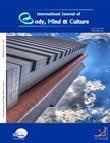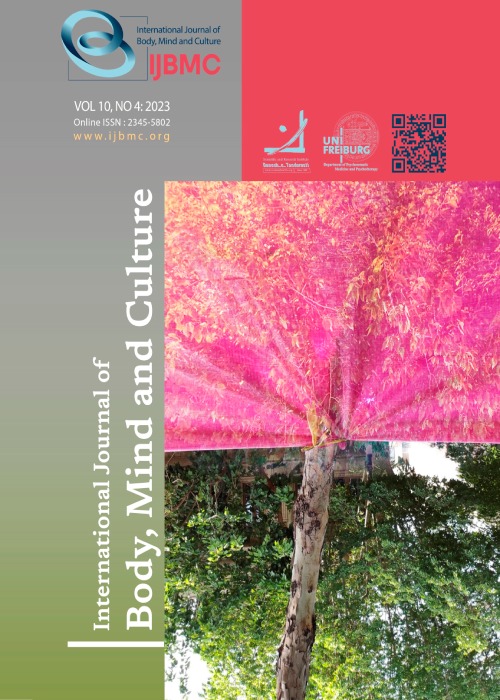فهرست مطالب

International Journal of Body, Mind and Culture
Volume:9 Issue: 2, Spring 2022
- تاریخ انتشار: 1401/02/24
- تعداد عناوین: 9
-
-
Pages 63-76
The national festival of CORONAREVAYAT (Corona Narrative) took place in the Iran Medical Council during the first peak of Covid-19 and lasted about a year, from April 26, 2020 to March 17, 2021. The festival was designed to provide a platform for networking between artists and health professionals, and to promote documentation in the field of public health. Weakness in epidemic documentation has deep roots in Iran. Thus, CORONAREVAYAT was conducted in the context of the public participation paradigm to increase the social sensitivity regarding documentation in the health sphere, through running a media campaign. Registration of 1022 works in the festival, publication of 10 volumes of books containing the selected works, attracting the professional support of 28 national organizations and the financial support of a private sector, participating in 3 international film festivals and 1 international painting festival, introducing some less-known concepts (e.g., health humanities and narrative medicine) to the public, and networking between artists and therapists can be considered as the most valuable achievements of CORONAREVAYAT, which outweigh its weaknesses (especially organizational bureaucratization). The predominance of image over text can be observed in scrutinizing the works registered in the festival, and can be attributed both to the ease of preparing image-based works with modern digital tools (especially cellphones) and to the greater desire of social media users to share photos and videos compared to text and articles. The least participation was observed in the research section of the festival, in this regard it can be stated that it seems that some concepts (e.g., research) have become so academically entrenched that academics are reluctant to engage in a public media campaign. The ambiguity in the definition of applied research and the negligence of universities in the field of science communication add to the complexity of this issue.
-
Pages 77-86Background
The Brief Illness Perception Questionnaire (B-IPQ) is one of the most widely used measures of emotional and cognitive representations of illness. The B-IPQ has been translated and adapted into many languages. However, the scale has not been translated into Iraqi Arabic in patients with type II diabetes. The main purpose of the present study was to investigate psychometric properties of the B-IPQ among Iraqi patients with type II diabetes.
MethodsIn this quantitative study, the Arabic Version of the B-IPQ was given to 192 Iraqi patients with type II diabetes. The participants were randomly selected from 5 hospitals and a diabetes society in Baghdad, Iraq. The participants included individuals diagnosed at least 1 year before this research. Using WINSTEPS computer program, the Rating Scale Model (RSM) was employed as a polytomous extension of the Rasch model (RM) to evaluate the scale in terms of unidimensionality, local independence, item statistics, and rating structures.
ResultsThe results indicated that the values of infit and oufit mean square (MNSQ) are within the ideal range of 0.60 and 1.40, suggesting that the items of the scale fit to the RM. The data was found to be unidimensional because the first factor explains 5.5% of the unexplained variance with an eigenvalue of 1.5 (< 2). The results also showed that items are locally independent, and both persons and items have high Rasch separation reliability indices. More importantly, the response options or categories of the scale work optimally because with the increase in category values, observed averages also increased.
ConclusionThe overall findings showed that the Arabic version of the B-IPQ is a valid and reliable instrument and can be employed to assess illness perceptions among Iraqi patients with type II diabetes.
-
Pages 87-96Background
Sexual health is one of the major aspects of health that is formed under the influence of various biological, social, psychological, and cultural factors. This study was conducted with the aim to determine the effects of a culture-based sexual health training course on the knowledge, attitude, performance, and self-efficacy of midwives in providing sexual health services.
MethodsThe present study was performed with a pretest-posttest design and follow-up. In total, 32 midwives were included in the online sexual health training course via the census sampling method. Accordingly, the knowledge, attitude, performance, and self-efficacy of the midwives were assessed using a researcher-made questionnaire before, immediately after, and 4 weeks after the intervention. Moreover, repeated measures ANOVA was used to determine the effects of the intervention.
ResultsComparing the results of pretest and posttest indicated that the training course significantly increased the midwives’ mean scores of knowledge (from 17.12 to 23.87), attitude (from 39.40 to 50.18), performance (from 36.18 to 46.15), and self-efficacy (from 27.31 to 39.28)..
ConclusionThis study indicated that running a culture-based training course on sexual health would be likely to improve professional capacity building in providing sexual health services. Given the importance of cultural and social issues in sexual health education, this course could play an effective role in helping midwives face and solve their clients’ problems.
-
Pages 97-105Background
The current research was conducted with the aim to examine the effectiveness of acceptance and commitment therapy (ACT) on COVID-19 induced anxiety among worried people in Ahvaz, Iran.
MethodsThis semi-experimental research was performed with experimental and control groups and a pretest-posttest design. The statistical sample of the research included all people worried due to COVID-19 in Ahvaz from among whom 30 were recruited using convenience sampling method and were randomly divided into the experimental or control groups. The subjects completed the Corona Disease Anxiety Scale (CDAS) designed by Alipour et al. in 2020. The experimental group received 8 sessions of ACT while the control group received no treatment. The data were analyzed using ANOVA in SPSS software.
ResultsThe results showed that after controlling for the pretest, the experimental group showed significant reduction in their anxiety score in comparison with the control group (P < 0.01).
ConclusionThe results of the research indicated that ACT effectively decreased subjects' COVID-19 induced anxiety through promoting psychological flexibility, decreasing struggle and control, and increasing mindfulness.
-
Pages 106-114Background
Headaches are a major focus of public health efforts. Because stress and emotional disturbances play a role in various forms of headaches, emotion regulation can be thought of as a factor in adaptation and successful control of this illness. The effectiveness of cognitive emotion management strategies in women and men with migraine headaches, tension headaches, and healthy people was investigated in this study.
MethodIn the first six months of 2020, 60 patients with migraine tension headaches were studied in the neurology clinic of the Abdi Waluyo Hospital in Jakarta. Positive techniques (vision formation, positive refocus, positive appraisal, and planning) and negative strategies (self-blame, blaming others, rumination, and catastrophic perception and acceptance) were obtained in emotion regulation using the Emotion Regulation Questionnaire.
ResultsAccording to the findings, persons with migraines employ fewer positive techniques in the cognitive management of their emotions than people without migraines. Meanwhile, the findings revealed that there is a substantial difference in the usage of positive methods by females and males in both groups, with females employing more positive tactics.
ConclusionIn conclusion, the findings of this study suggest that self-regulation is one component that can cause headaches in patients.
-
Pages 115-128Background
Irritable bowel syndrome (IBS) is a critical syndrome that harms the psychological, communicational, social, and emotional processes of individuals. Considering the importance of this topic, the present study was conducted with the aim to examine the relationship between motivational structure, traumatic events, and psychological distress tolerance mediated by ambiguity intolerance in individuals with IBS.
MethodsThe present correlational research was conducted using structural equation modeling (SEM). The statistical population comprised all individuals with IBS referring to the Digestive Disease Research Institute of Shariati Hospital, Iran, in 2020. From among these patients, 177 individuals were selected using convenience sampling method. The data were gathered using the Kessler Psychological Distress Scale (K10), Personal Concerns Inventory (PCI), Ambiguity Tolerance Scale-II (MSTAT-II), and Life Events Checklist (LEC). SPSS software was used for the preliminary data analysis and SmartPLS software was used for PLS modeling.
ResultsThe results of data analysis indicated the direct effect of adaptive motivation structure and traumatic events on distress tolerance. The aforementioned variables could also affect the distress tolerance of individuals with IBS by influencing their ambiguity tolerance (P < 0.01). However, traumatic events had a higher indirect effect through ambiguity tolerance compared to their direct effect. Furthermore, adaptive motivation structure had no significant direct or indirect effect on distress tolerance.
ConclusionThis study confirmed the relationship between motivational structure and traumatic events with the mediating role of ambiguity intolerance among IBS sufferers. Furthermore, further studies must be conducted on ambiguity tolerance and the problems of individuals with IBS regarding the plethora of scientific evidence on the etiology of IBS syndrome.
-
Pages 129-139Background
This study was conducted with the aim to investigate the effectiveness of a psychological bioenergy economy intervention on the cardiac function and inflammatory factors in patients with myocardial infarction (MI).
MethodsThis randomized controlled trial (RCT) was performed on 60 post-MI patients who referred to the Cardiovascular Research Institute, Isfahan, Iran, in 2019. The intervention group received an energy-based bioenergetics intervention that consisted of rehabilitation training and nutrition patterns training. In the control group, only rehabilitation training and nutrition pattern training was provided in 8 sessions. Quantitative data were expressed as mean ± standard deviation (SD). Between-group differences of data departing from normal distribution were analyzed using the Mann-Whitney U test. All statistical analyses were performed in SPSS software.
ResultsThe enrolled patients included 60 post-MI patients (27.3% women in the intervention group, and 18.2% in the control group). We lost 16 patients during the study. Fasting blood sugar was higher in the control group before the intervention (106.7 ± 14.1 vs. 96.3 ± 11.0; P < 0.001). Systolic blood pressure was significantly higher in the control group before the intervention (P = 0.04). There was no significant difference in total cholesterol, TG, HDL, and LDL after the intervention compared to before the intervention in either groups. Intercellular adhesion molecule 1 (ICAM-1) and vascular cell adhesion molecule 1 (VCAM-1) did not change during the intervention in either groups (P < 0.05).
ConclusionOur results displayed that the psychological intervention based on bioenergy economy has no significant effect on cardiac function and inflammatory factors in patients with MI. However, it is suggested that this study be repeated on a larger population.
-
Pages 140-148Background
Overweight is one of the current problems of people. One of its causes is the craving for food. This study was conducted with the aim to evaluate the effectiveness of transcranial direct current stimulation (tDCS) on craving for food in overweight people.
MethodsThe research was a quasi-experimental study with a pretest-posttest design and a control group. The statistical population of the study included all overweight people referred to Aramesh Psychology Center in Tehran, Iran, in 2019. They were selected using a purposeful sampling method and were randomly divided into two groups. The mean and standard deviation of the age of the subjects was 34.27 ± 6.45 years and the mean body mass index (BMI) was 28.12 ± 2.23 kg/m2. The research instrument was the Food Cravings Questionnaires (FCQs) developed by Cepeda-Benito, Gleaves, Williams, and Erath (2000). Data were analyzed using multivariate analysis of covariance (ANCOVA).
ResultsThe results showed a significant difference between the tDCS group and control group in terms of mean trait craving (P ≥ 0.001) and state craving (P ≥ 0.001) scores.
ConclusionIt seems that tDCS can be used to reduce food cravings in obese people. Theoretical and practical considerations of the research have been presented in the discussion and conclusion sections.


